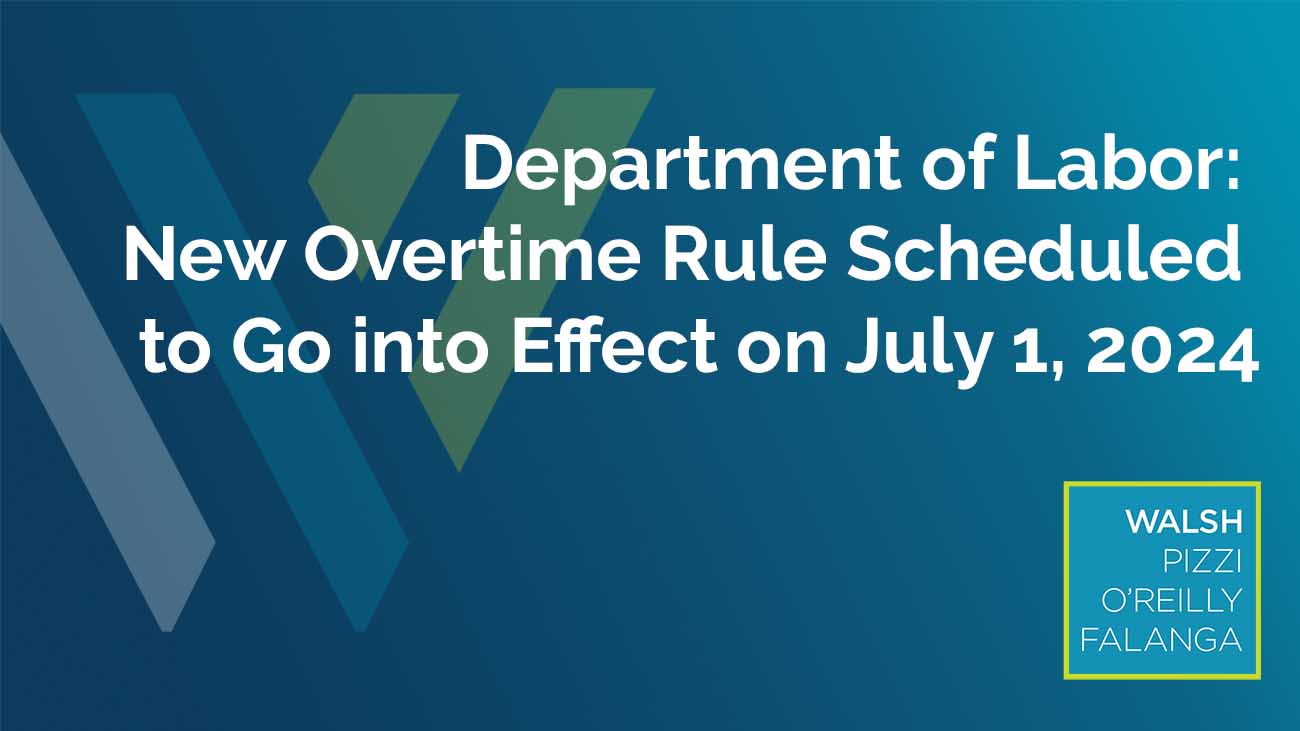
Department of Labor: New Overtime Rule is Scheduled to Go into Effect on July 1, 2024
The Department of Labor (DOL or Department) promulgated a new rule that is to go into effect on July 1, 2024. The final rule updates and revises the regulations issued under section 13(a)(1) of the Fair Labor Standards Act (FLSA) implementing the exemption from minimum wage and overtime pay requirements for executive, administrative, and professional (EAP) employees. Revisions include increases to the standard salary level and the highly compensated employee total annual compensation threshold, and a mechanism that provides for the future updating of these earnings thresholds to reflect then-current earnings data.
Under the current law, salaried workers who are paid over $35,568 per year are exempt from the FLSA’s overtime regulations, meaning they are not entitled to overtime pay (one and one-half times their regular pay for working over 40 hours per week). Under the new law, the salary threshold is increased to $43,888, meaning salaried workers who work over 40 hours per week and make less than $43,888 per year will be eligible for overtime pay. The Department will raise this threshold to $58,656 per year on January 1, 2025.
The rule will also increase the total annual compensation requirement for highly compensated employees (who are not entitled to overtime pay under the FLSA if certain requirements are met) from $107,432 per year to $132,964 per year on July 1, 2024, and then set it equal to $151,164 per year on January 1, 2025.
These thresholds will be automatically updated every three years to reflect earnings data and other market implications. The current duties tests or salary basis requirements as to how overtime should be calculated – time and a half in excess of 40 hours per week – have not been changed.
Potential Legal Challenges:
Two challenges to the DOL’s new rule have been filed in Texas federal courts. The nature of the challenges include:
-
- The rule is invalid because the salary increase is too large;
- The DOL lacks the authority to impose a threshold at all;
- Automatic updates to the salary thresholds are invalid because a notice and comment rule-making period must occur prior to each change;
- The DOL’s rulemaking does not comply with the Administrative Procedure Act (APA), which governs the process by which federal agencies develop and issue regulations; and
- Enforcing these rules infringes on states’ sovereignty.
How Employers Should Address This New Rule by Formatting a Plan:
At this time, the rule remains set to go into effect. Therefore, employers should consider compliance plans that include the following steps:
- Identify which employees are impacted by the rule to determine the total amount of employees that will be exempt
- Once it has been determined who is impacted, determine a response
- Potential Response 1: Increase salaries to ensure employees remain exempt
- Consideration: convert non-salary employment benefits into salaried pay to reach the salary threshold
- Potential Response 2: Reclassify employees as non-exempt and pay those employees overtime
- Potential Response 3: Implement an organization restructuring plan by increasing salaried pay for others while terminating employment of non-exempt employees to offset costs
- Potential Response 1: Increase salaries to ensure employees remain exempt
Plan Considerations For Employers:
When considering options for addressing the new rule, employers should keep in mind that increasing salaries for a portion of employees may result in salary compression. Additionally, reclassification of employment across an organization may lower overall employee morale. Employers should always consider state laws during planning. Given the pending challenges to the new rule, employers should think about implementing salary increases close to or on July 1 in the event this rule is placed on hold.
Department of Labor Recommendations for Communication to Employees on Changes:
The DOL recommends certain strategies for communicating these rule changes to employees. For example, the DOL indicates that organizations should train newly non-exempt employees on internal time keeping systems. Organizations also should provide information on time keeping with respect to mealtimes, breaks, work hours, and use of personal devices while on the clock. The DOL also recommends that organizations coordinate with their Human Resources teams to prepare materials such as FAQs to address employee questions and concerns related to the new rule.
For any questions on the new DOL rule or to discuss strategies for addressing the salary thresholds, please contact Walsh’s Labor & Employment law practice group.
This article was authored by Walsh Pizzi O’Reilly Falanga LLP Summer Associate and Fordham University School of Law J.D. Candidate, Alexandra Arleo.

